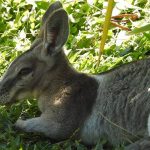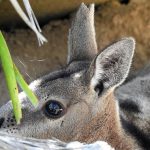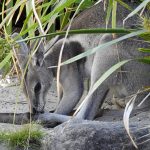BRIDLED NAIL-TAIL WALLABY
The Bridled nail-tail wallaby: A Survivor of the Outback
Hidden beneath the soft moonlight of central Queensland, a small and agile marsupial quietly grazes on tender grasses—a living tale of survival and resilience. This is the Bridled nail-tail wallaby a rare gem among Australia’s unique fauna. Once believed to have vanished from Earth, its remarkable rediscovery is a beacon of hope and a reminder of nature’s delicate balance.
Physical Description
Imagine a creature no larger than a household cat, balanced on long, powerful hind legs. The Bridled nail-tail wallaby displays:
- Size: 40–60 cm in body length (not including the tail), weighing between 2–5 kilograms.
- Distinguishing Features:
- Compact body and short snout
- Long tail with a crisp white tip
- Greyish-brown coat
- A bold dark stripe running from nape to shoulders, like the strap of a bridle—a feature that inspired its common name.
When viewed up close, the wallaby’s fur seems to shimmer in varying shades of brown and silver-grey, perfectly blending with dappled moonlight and the shadows of tall grass.
Habitat and Distribution
| Former Range | Current Range |
|---|---|
| Broadly dispersed across eastern Australia | Restricted to small regions in central Queensland |
The wallaby’s ideal home comprises:
- Open grasslands with scattered trees
- Woodlands and shrublands with low vegetation and abundant cover
You might feel the cool evening air and hear the gentle rustle of dry grasses as the wallaby moves quietly, always alert to the sounds and scents of night.
Behaviour and Adaptations
Activity Patterns
- Nocturnal and crepuscular: Most active at night and in the soft light of dawn and dusk
- Solitary: Often found alone, blending into the landscape, though sometimes sharing feeding grounds
Special Traits
- Jumping Ability: Its long hind legs are adapted for swift and nimble leaps, helping it escape danger or search for food.
- Alarm Signalling: The distinct thump of its hind feet, echoing across the grass, warns others of nearby threats—a simple yet effective language of survival.
Diet and Foraging
The Bridled nail-tail wallaby chooses its meals carefully:
- Enjoys nutritious grasses, herbs, and low-growing vegetation
- Selectively feeds on the freshest and most energy-rich plant parts
- Its small size allows it to access patches of greenery missed by larger grazers
Picture the wallaby under starlit skies, gently tugging at dew-kissed shoots, the scent of damp earth rising as it dines by moonlight.
Reproduction and Life Cycle
- Pouch-living marsupial: Females nurture their young (joeys) in a soft, protective pouch.
- Gestation: Around 30–35 days before a tiny, delicate joey is born.
- Development: The joey, blind and hairless, instinctively climbs into the pouch. There, it nurses and grows for several months, gradually emerging for brief adventures before finally leaving the pouch for good.
Conservation Status
| Region | Status |
|---|---|
| New South Wales | Extinct |
| Commonwealth | Endangered |
| Queensland | Remnant populations |
For decades, the Bridled nail-tail wallaby was thought extinct—until 1973, when a chance sighting by a local farmer led to the discovery of a surviving outback population. This event rekindled hope and launched urgent conservation efforts.
Threats and Challenges
Factors that led to the wallaby’s decline include:
- Hunting: Once culled for its fur and considered an agricultural pest.
- Habitat Loss: Widespread clearing for farmland and livestock pasture reduced the areas where it could safely live and feed.
- Environmental Change: Ongoing habitat modification, recurring drought, altered fire regimes, and the spread of invasive weeds (such as buffel grass) have further eroded suitable territory.
- Predation: Introduction of dogs, foxes, and feral cats brought new predators.
- Competition: Introduced sheep and rabbits compete for precious food sources.
Conservation: A Story of Hope
The Bridled nail-tail wallaby’s survival is a delicate thread in the broad tapestry of Australia’s natural heritage. Conserving remaining populations means:
- Protecting and restoring native habitats
- Managing introduced predators and competitors
- Supporting breeding and reintroduction programs
Imagine the quiet joy of encountering this elusive wallaby as the dawn breaks; each sighting is a gift earned by decades of persistent conservation.
A Call to Appreciation
Every Bridled nail-tail wallaby is a living testament to resilience. Their continued existence offers us a unique opportunity to reflect on our relationship with the natural world—and inspires us to act as custodians for all that is rare and beautiful.
To preserve the Bridled nail-tail wallaby is to safeguard a story of survival, one that belongs not only to Australia but to the world.
Let us be guided by both the science and the spirit of discovery, ensuring that this remarkable marsupial continues to leap through the wild landscapes of tomorrow.






